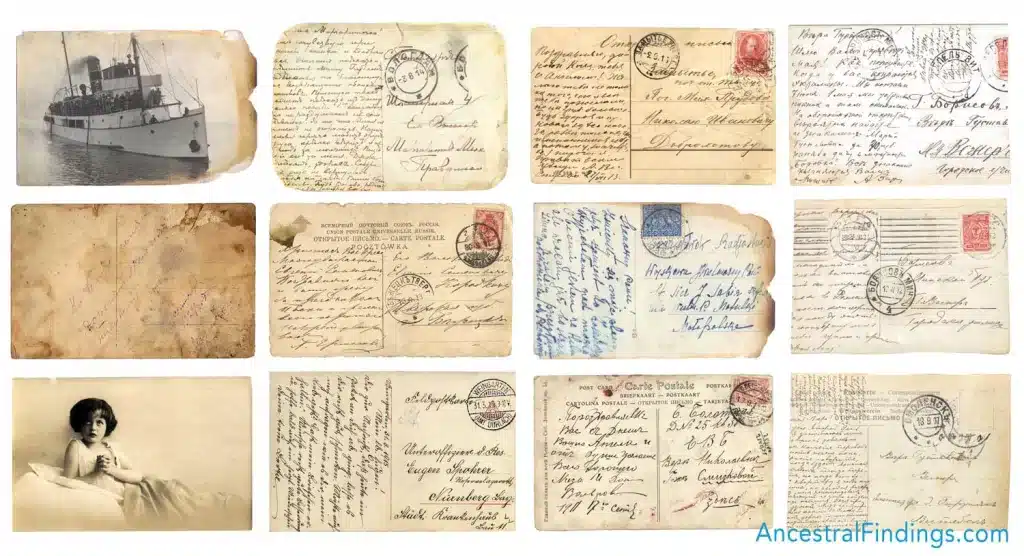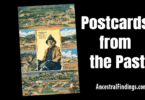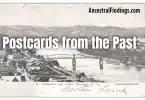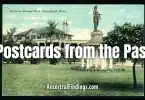Every postcard has its surprises, and this one from my collection is a little unusual. Instead of showing a scenic view or a tourist attraction, it shows a mural of a man who was both feared and admired: Jesse James, the famous Missouri outlaw. The mural is located inside the Missouri State Capitol in Jefferson City, and the fact that it ended up on a postcard tells you a lot about how Americans have remembered Jesse James—not just as a criminal, but as a larger-than-life figure of folklore.
The postcard was published by Blair Cedar & Novelty Works of Camdenton, Missouri, with printing by Colorpicture of Boston, Massachusetts. Like many linen-era cards, it’s vivid and bold, with stylized colors that almost make the mural look alive. On the front, the mural shows Jesse James and his gang in the middle of a train robbery—a scene that has become part of American legend. Farmers and workers stand in the background, symbolizing the state’s broader history, while the train steams through the center as the action unfolds. It’s a striking image: outlaw life turned into high art, displayed in the very heart of Missouri government.
The Mural in the Capitol
The mural is part of a larger series painted inside the Missouri State Capitol, many of which were created during the 1920s and 1930s. The state decided to use public art to tell the story of Missouri’s past. Artists were commissioned to fill the Capitol with scenes of history—explorers, settlers, agriculture, industry, politics, and yes, even outlaws.
Why outlaws? Because they were part of Missouri’s story. The Capitol murals didn’t shy away from the darker, more dramatic parts of history. They showed Jesse James not as a simple villain, but as a symbol of the turbulent times after the Civil War. Murals like this one were meant to be both educational and eye-catching, giving visitors a sense of the characters who had shaped the state, for better or worse.
That’s what makes this postcard so fascinating. Instead of just being a pretty view of Jefferson City or the Capitol dome, it zooms in on a dramatic piece of artwork inside the building—something visitors would see on a tour and perhaps want to remember by sending home a postcard.
Who Was Jesse James?
Jesse James was born in Clay County, Missouri, in 1847. During the Civil War, Missouri was a deeply divided state. Jesse, along with his older brother Frank, joined Confederate guerrilla groups known as “bushwhackers.” They fought in brutal skirmishes and raids, often blurring the line between warfare and banditry.
After the war ended, Jesse and Frank didn’t return quietly to farm life. Instead, they turned to outlawry. Along with their gang, which at times included the Younger brothers, they robbed banks, stagecoaches, and trains across Missouri and neighboring states. One of their most famous robberies was the 1876 raid on the First National Bank of Northfield, Minnesota. The raid went badly, and most of the gang was killed or captured. Jesse and Frank barely escaped, and their legend only grew.
Jesse James became both a criminal and a folk hero. Newspapers sensationalized his exploits, and many poor farmers saw him as a kind of Robin Hood figure, striking back at the railroads and banks they believed exploited ordinary people. Whether Jesse ever actually gave to the poor is doubtful, but the myth took root.
His story ended in 1882, when Jesse was shot in the back of the head by Robert Ford, a member of his own gang who hoped to collect a reward. Jesse was only 34 years old, but by then, his legend was already larger than life.
Why Paint Jesse James in the Capitol?
It may seem odd that Missouri would honor an outlaw in its state Capitol. But Jesse James was more than just a criminal—he was a symbol of Missouri’s identity. He represented the state’s divided loyalties during the Civil War, its struggles during Reconstruction, and its role in the great expansion of the American frontier.
By the time the murals were painted, Jesse James had become a legend, the subject of dime novels, ballads, and even early silent films. He was remembered as a figure of adventure, rebellion, and drama. For Missouri, including Jesse in the Capitol murals was a way of acknowledging that the state’s history wasn’t just about politicians and generals—it was also about the people who lived on the margins, for better or worse.
The mural isn’t a simple tribute. It shows Jesse and his gang robbing a train, a reminder of the violence that came with his name. But by placing him in the Capitol alongside farmers, workers, and leaders, the artist wove him into Missouri’s larger story.
Jesse James in Folklore and Popular Culture
Part of what makes this postcard so interesting is that Jesse James wasn’t just a Missouri figure—he became a national legend. After his death, the stories only grew. Songs were written about him. Dime novels turned him into a romantic figure. Hollywood later followed, with dozens of films about Jesse and Frank James, each one blurring fact and fiction a little more.
Even today, Jesse James shows up in books, movies, and television shows. He’s part of the American fascination with outlaws—the idea that some people lived outside the law, taking risks and defying authority in ways that both shocked and thrilled ordinary citizens.
This postcard is a small part of that tradition. By turning Jesse James into postcard art, the publishers were tapping into the same fascination that had kept his name alive for decades.
Postcards and Outlaws
Postcards were not always just about scenery. Sometimes they captured history, folklore, and legend. A mural of Jesse James in the Missouri Capitol might seem like an odd subject for a postcard, but it fit right into the American habit of turning outlaw stories into souvenirs.
Travelers who toured the Capitol could buy this card, send it home, and say, “Look what I saw in Missouri—the outlaw Jesse James painted on the walls of the statehouse.” It’s both a piece of state pride and a reminder that history is complex. Missouri embraced Jesse James not because he was admirable, but because he was unforgettable.
Why This Card Matters to My Collection
I value this postcard because it shows the unexpected side of history. Most Capitol postcards show grand domes, legislative chambers, or stately statues. But this one zooms in on a mural of a train robbery. It’s history with grit, history that acknowledges the rough edges.
Holding this card, I’m reminded that the past isn’t always neat and tidy. Sometimes it’s violent, dramatic, and controversial. And sometimes, those stories are the ones that endure the longest.
If you happen to have old postcards laying around your house, I’d love to see them. You can send them my way. Just go to the contact link on AncestralFindings.com and let me know, and I’ll be glad to share my address with you. Who knows—your postcard might be the next one I write about in a future article.







